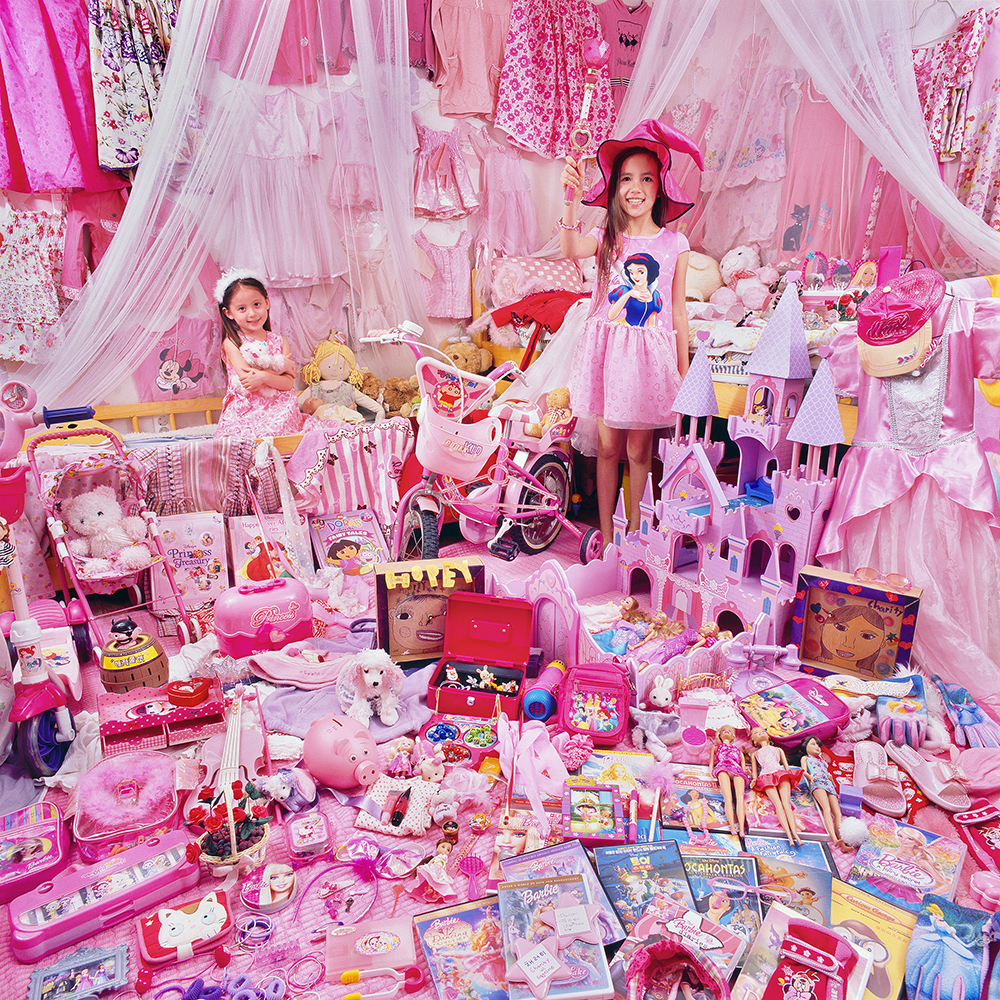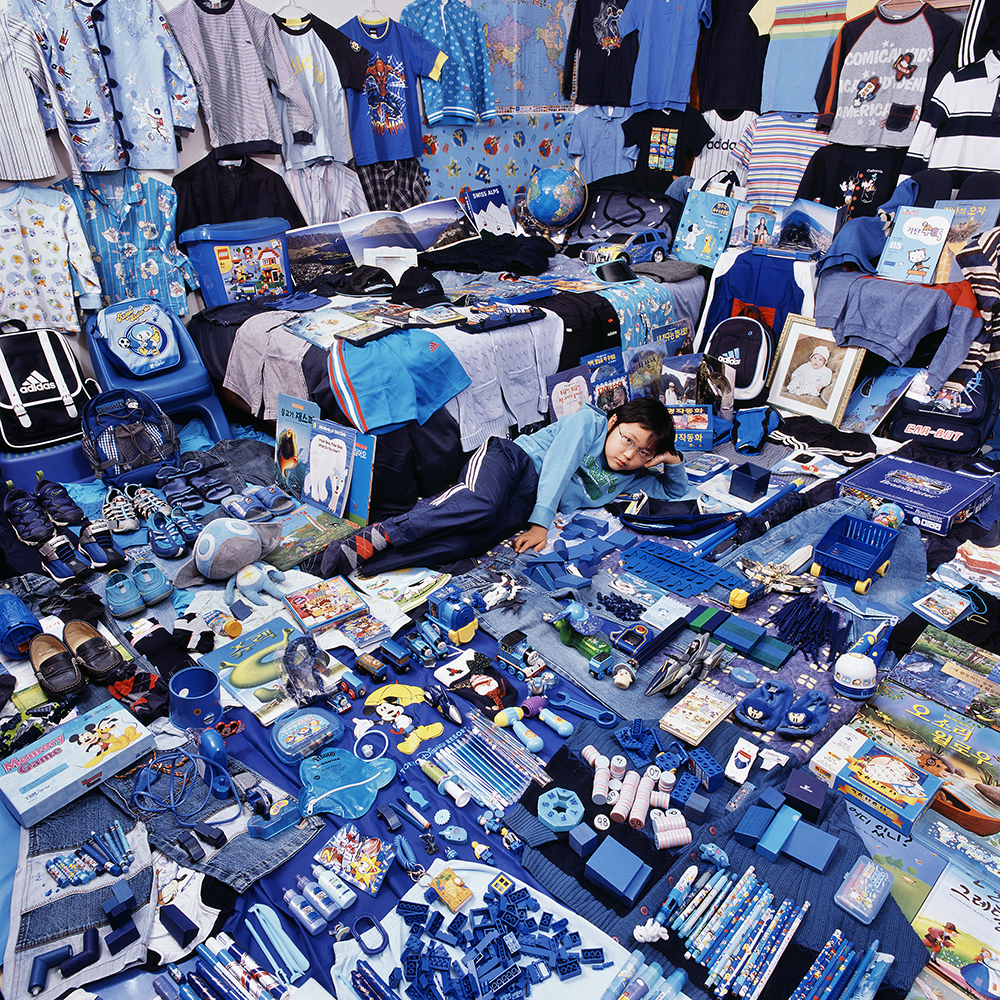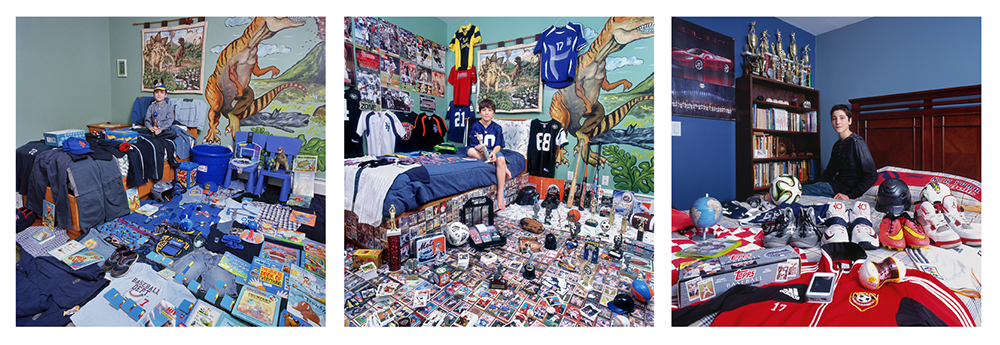South Korea Week: JeongMee Yoon: The Pink and Blue project
Photography as a contemporary art plays a very special and important role. Unlike any other mediums, it has the unique ability to document and capture images of the real-life. Even the work of hyperrealistic paintings cannot compare to what cameras can do, which has the ability to record the facts of existence. This exact realism is something that can only be achieved through photography as a contemporary art and further, the artistic themes that a photographer places in their work arouses the various senses and interests of the viewer.
Camera Obscura was a technique used in painting before cameras were invented. However, at some point, paintings were no longer the sole medium for portraying the real world and subsequently, started to take a new artistic identity. Regardless, while the invention of the camera had a large impact in art history, some types of photography take inspiration from paintings and depict their shots as such. Further, there is a unique, symbiotic relationship between photography and painting in the art world and it is a phenomenon that is important to try to understand.
In this article, I want to introduce JeongMee Yoon, one of South Korea’s highly-acclaimed contemporary art photographers. Her name is actually well-known across the world as well. She has received major awards in South Korea and to this day, is working diligently on new exhibitions and series. I first met Yoon in 2014 when I got the chance to take her photography class. Her first impression was quiet, yet cold; I remember her with thick, black-framed glasses on. However, this impression didn’t last for long. Quickly, she showed her true color: one that was flowing with warmth and kindness. One day in her class, it was my turn to do a project presentation. My project was a memoir to my close friend who passed away a few years ago and it consisted of photographs and writings. As she read my essay, she started to shed tears and had to pause the class. That moment reaffirmed a trait that I admire of artists who have incredible purity, innocence and emotional sensitivity.
A year later in 2015, Yoon came out with a series titled which included a piece that was taken of our family and our two cocker spaniels. We took the photo at our home, and because of that, she brought all of her heavy equipment to our place. Even with her slender body type, she moved all of our furniture and the equipment multiple times to stage the perfect photo. This showed a dedication to her craft as a photographer and most certainly, this event got us even closer.
Most of her work focuses on capturing individuals and people. When you observe her series, it will be evident the wide-range of people she has met and the places she’s travelled to. A single picture overflows with objects and materials as well as behind the scenes equipment. She also prefers to take the photos in the people’s intimidate living spaces. Anyone involved in photography will be well aware that this is a tedious and tiresome effort. It is clear that Yoon has a burning passion for photography and that passion makes her a pivotal figure in our field.
Born in Seoul, South Korea in 1969, JeongMee Yoon majored in painting at Seoul National University, Seoul, photography design at Hongik University, Seoul, and studied at the School of Visual Arts, New York, USA.
As a winner of the Daum Prize in 2006, she held a successful solo exhibition at Kumho Museum of Art in South Korea, and ‘The Pink and Blue Project‘ book was published by the Parkgeonhi Foundation (Seoul, South Korea) in 2007, and ‘Animal Companions’ book was published by IANN publisher (Seoul, South Korea) in 2015.
Also, In 2011, She won the first Prize at The Sovereign Asian Art Prize, Hong Kong with ‘The Pink & Blue Project II’, and the Ilwoo Photography Award in Seoul, South Korea, in 2018. ‘The Pink & Blue Project’ book was published by Hatje Cantz publisher in Germany in 2018.
Yoon’s works have been illuminated not only by numerous group exhibitions at museums in Europe, USA, Asia, but also by high-profile solo exhibitions of The Pink & Blue Project showed at Gallery Inn in Seoul, South Korea, Jenkins Johnson Gallery in New York, San Francisco, and La Caja Blanca Gallery in Spain. Her works has aslo been collected by enterprises and both prominent museums around the words.
Photographers are like a magnet. When a photographer focuses their attention on something they want to portray, it’s as if their artistic sense is like iron powder sticking to a magnet; the force and intensity at which they try to make their vision come true is palpable.
This is particularly so of photographer Yoon.
The Pink and Blue Project started out very spontaneously, she recalls. However, I don’t think this was a coincidence at all; she has always had an extremely detailed sense which helped her to conceptualize this project. This series took inspiration from her daughter playing with a hula hoop and the series symbolizes a larger societal topic. Her work isn’t specific to just the eastern or western world. She wanted to touch on the universal societal issues around sexism and shed light on the traditional perceptions societies have of men and women. Unfortunately, there have been photographers and critics alike who spoke on the fact that there are too many works of this same topic and that it has been played out. However, there can never be enough or too much of a certain topic of work. As photography artists of the contemporary age, the work that each and one of them produce is special and part of a greater whole. Although their work may feel like a single grain of sand, the power of an individual photographer’s passion is strong enough to create sand dunes. And this project is a perfect example of that.
The Pink & Blue Project
JeongMee Yoon
The Pink & Blue project explores the trends in cultural preferences and the differences in the tastes of children (and their parents) from diverse cultures, ethnic groups as well as gender socialization and identity. The work also raises other issues, such as the relationship between gender and consumerism, urbanization, the globalization of consumerism and the new capitalism.
The Pink and Blue Projects were initiated by my five-year-old daughter, who loves the color pink so much that she wanted to wear only pink clothes and play with only pink toys and objects. I discovered that my daughter’s case was not unusual. In the United States, South Korea and elsewhere, most young girls love pink clothing, accessories and toys. This phenomenon is widespread among children of various ethnic groups regardless of their cultural backgrounds. Perhaps it is the influence of pervasive commercial advertisements aimed at little girls and their parents, such as the universally popular Barbie and Hello Kitty merchandise that has developed into a modern trend. Girls train subconsciously and unconsciously to wear the color pink in order to look feminine.
Pink was once a color associated with masculinity, considered to be a watered down red and held the power associated with that color. In 1914, The Sunday Sentinel, an American newspaper, advised mothers to “use pink for the boy and blue for the girl, if you are a follower of convention.” The change to pink for girls and blue for boys happened in America and elsewhere only after World War II. As modern society entered twentieth century political correctness, the concept of gender equality emerged and, as a result, reversed the perspective on the colors associated with each gender as well as the superficial connections that attached to them. Today, with the effects of advertising on consumer preferences, these color customs are a worldwide standard.
The saccharine, confectionary pink objects that fill my images of little girls and their accessories reveal a pervasive and culturally manipulated expression of “femininity” and a desire to be seen. To make these images, I arrange and display the cotton – candy colored belongings of several children in their rooms. When I began producing the pink images, I became aware of the fact that many boys have a lot of blue possessions. Customers are directed to buy blue items for boys and pink for girls. In the case of my eleven-year-old son, even though he does not seem to particularly like the color blue over other colors, whenever we shop for his clothes, the clothes he chooses are from the many-hued blue selection. The clothes and toy sections for children are already divided into pinks for girls and blues for boys. Their accessories and toys follow suit.
The differences between girls’ objects and boys’ objects are also divided and affect their thinking and behavioral patterns. Many toys and books for girls are pink, purple, or red, and are related to make up, dress up, cooking, and domestic affairs. However, most toys and books for boys are made from the different shades of blue and – are related to robots, industry, science, dinosaurs, etc. This is a phenomenon as intense as the Barbie craze. Manufacturers produce anthropomorphic ponies that have the characteristics of young girls. They have barrettes, combs and accessories, and the girls adorn and make up the ponies. These kinds of divided guidelines for the two genders deeply affect children’s gender group identification and social learning.
As girls grow older, their taste for pink changes. Until about 2nd grade, they are very obsessed with the color pink, but around 3rd or 4th grade, they do not obsess with pink as much anymore. Usually, their tastes change to purple. Later, there is another shift. However, the original association with the color-code often remains.
When I take pictures, I begin the photographic session by arranging the larger items blankets and coats, and then spread the smaller articles on the bed and floor. When I first started taking these pictures, the objects were arranged without an order, but I soon realized that the photographs in which small possessions are well organized and displayed in the front of scene make the images appear to be more crowded. This method shows my organization of subjects similar to the way in which museums categorize their inventories and display their collections.
The subjects’ expressions and poses are very important elements in my pictures. I ask each model to sustain a blank, neutral expression to underline an “objectification” of each child and I request various poses to heighten the differences in gender and personal characteristics among my subject. I also ask for feminine and masculine expressions and poses of them. I use five to eight rolls of films and choose the best picture among the sixty to ninety proofs. Sometimes, I get an unexpected gesture of expression that represents the child well. Their subtle gestures and poses are related to their own characters as well as my intention. It is a puctum of my pictures, so my The Pink and the Blue Projects seem very similar, but subtle and interesting characteristics of each model emerge.
To capture the crucial photographic moment of a child’s facial expression as well as to assure that the fine details can be seen, I used a medium format camera. Because children are not always able to attain or hold the desired expressions and poses, I take several rolls of film at each shoot. I use a 6×6 format Hasselblad camera to make the objects seem more crowded and spectacular; this works better with a square frame rather than a rectangular one. To achieve a hyper-realistic painterly quality of the objects and subjects, I use the smallest aperture, f-22. In some of the pictures, the children are placed in the background and this, coupled with their blank facial expressions, give them a doll-like appearance. Diffused lighting is used in order to flash all the articles in a small room evenly.
The Pink & Blue Project I (2005 – ongoing) is a three part series of images created in order to explore gender stereotypes through the use of color. The original series, The Pink &Blue Project I, was made in 2005 of girls with their pink belongings, and boys with their blue belongings, revealing how society pushes color preferences according to gender onto young children through consumer culture. The Pink & Blue Project II is a follow up series of images of the same children four years later. My current series The Pink & Blue Project III, which will be seen for the first time in this exhibition, features new work created ten years after the original series, in 2015.
I witnessed my subject grow up, from babies, toddlers and young children to teens and eventually some of them became college students. Some of my older subjects remained steadfast in their preference for the same pink or blue objects. Others changed color preference or became ambivalent about color identification. Some declined to pose for photos because they had reached puberty and no longer felt comfortable in front of the camera. Others were too busy to have their pictures taken. But many subjects agreed to sit for me for a third time. The Pink & Blue Project III is the culmination of a decade long investigation of color coding as associated with gender.
While The Pink & Blue Project I reveals prevailing gender-related color codes expected by the society, The Pink& Blue Project III captures one’s journey of growing up. In viewing the time lapse between the three images represented for each subject, we can observe the evolution of these subjects as they change physically and develop new personal preferences in relation to their objects. My new work examines my subjects more deeply, after the facade of color fades away.
Ms. Lee held acclaimed solo exhibitions in galleries throughout Seoul, South Korea and has received numerous awards. Most recently, she received First Place and the Richards’ Family Trust Award at the 25th Annual Juried Members’ Exhibition, held in Griffin Museum. In Spring 2018, her series was selected by South Korea’s Now Gallery for the “New and Now Exhibition” award and was exhibited at the Donggang International Photo Festival. She also received a gold medal at the San Francisco Bay Area International Photo Festival for one of her most recognized pieces, Jacqueline.
Posts on Lenscratch may not be reproduced without the permission of the Lenscratch staff and the photographer.
Recommended
-
Earth Week: Aaron Huey: Wallpaper for the End of the WorldApril 26th, 2024
-
Earth Week: Casey Lance Brown: KudzillaApril 25th, 2024
-
Tara Sellios: Ask Now the BeastsApril 6th, 2024
-
ALEXIS MARTINO: The Collapsing Panorama April 4th, 2024
-
Emilio Rojas: On Gloria Anzaldúa’s Borderlands: The New MestizaMarch 30th, 2024












































































